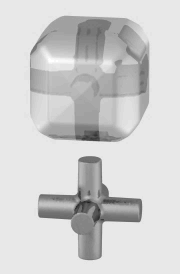Solid modeling
Solid modeling is a consistent set of principles for mathematical and computer modeling of three-dimensional solids. Solid modeling is distinguished from related areas of geometric modeling and computer graphics by its emphasis on physical fidelity. Together, the principles of solid modeling form the foundation of computer-aided design (CAD) and computer-aided engineering (CAE).
History[edit | edit source]
The development of solid modeling began in the 1960s and 1970s with the advent of computer graphics and the need for more accurate representations of physical objects. Early systems were based on wireframe modeling, which represented objects as a collection of lines and curves. However, wireframe models were ambiguous and could not represent the interior of objects. This led to the development of surface modeling, which represented objects as a collection of surfaces. While surface models were more accurate, they still could not represent the interior of objects.
The breakthrough came with the development of boundary representation (B-rep) and constructive solid geometry (CSG) techniques. B-rep represents objects as a collection of surfaces that define the boundary of the object, while CSG represents objects as a combination of primitive solids using Boolean operations.
Techniques[edit | edit source]
Solid modeling techniques can be broadly classified into two categories: boundary representation (B-rep) and constructive solid geometry (CSG).
Boundary Representation (B-rep)[edit | edit source]
B-rep represents a solid as a collection of surfaces that define its boundary. These surfaces are typically represented as NURBS (Non-Uniform Rational B-Splines) or polygonal meshes. B-rep is widely used in CAD systems because it provides a precise and flexible way to represent complex shapes.
Constructive Solid Geometry (CSG)[edit | edit source]
CSG represents a solid as a combination of primitive solids (such as cubes, spheres, and cylinders) using Boolean operations (union, intersection, and difference). CSG is particularly useful for representing objects that can be easily decomposed into simpler shapes.
Applications[edit | edit source]
Solid modeling is used in a wide range of applications, including:
- Computer-aided design (CAD)
- Computer-aided engineering (CAE)
- Finite element analysis (FEA)
- Computer-aided manufacturing (CAM)
- 3D printing
- Virtual reality
Software[edit | edit source]
Several software packages are available for solid modeling, including:
Related Pages[edit | edit source]
- Geometric modeling
- Computer graphics
- Computer-aided design
- Computer-aided engineering
- Finite element analysis
- 3D printing
- Virtual reality
- AutoCAD
- SolidWorks
- CATIA
- PTC Creo
- Siemens NX
- Blender
Search WikiMD
Ad.Tired of being Overweight? Try W8MD's physician weight loss program.
Semaglutide (Ozempic / Wegovy and Tirzepatide (Mounjaro / Zepbound) available.
Advertise on WikiMD
|
WikiMD's Wellness Encyclopedia |
| Let Food Be Thy Medicine Medicine Thy Food - Hippocrates |
Translate this page: - East Asian
中文,
日本,
한국어,
South Asian
हिन्दी,
தமிழ்,
తెలుగు,
Urdu,
ಕನ್ನಡ,
Southeast Asian
Indonesian,
Vietnamese,
Thai,
မြန်မာဘာသာ,
বাংলা
European
español,
Deutsch,
français,
Greek,
português do Brasil,
polski,
română,
русский,
Nederlands,
norsk,
svenska,
suomi,
Italian
Middle Eastern & African
عربى,
Turkish,
Persian,
Hebrew,
Afrikaans,
isiZulu,
Kiswahili,
Other
Bulgarian,
Hungarian,
Czech,
Swedish,
മലയാളം,
मराठी,
ਪੰਜਾਬੀ,
ગુજરાતી,
Portuguese,
Ukrainian
Medical Disclaimer: WikiMD is not a substitute for professional medical advice. The information on WikiMD is provided as an information resource only, may be incorrect, outdated or misleading, and is not to be used or relied on for any diagnostic or treatment purposes. Please consult your health care provider before making any healthcare decisions or for guidance about a specific medical condition. WikiMD expressly disclaims responsibility, and shall have no liability, for any damages, loss, injury, or liability whatsoever suffered as a result of your reliance on the information contained in this site. By visiting this site you agree to the foregoing terms and conditions, which may from time to time be changed or supplemented by WikiMD. If you do not agree to the foregoing terms and conditions, you should not enter or use this site. See full disclaimer.
Credits:Most images are courtesy of Wikimedia commons, and templates, categories Wikipedia, licensed under CC BY SA or similar.
Contributors: Prab R. Tumpati, MD



